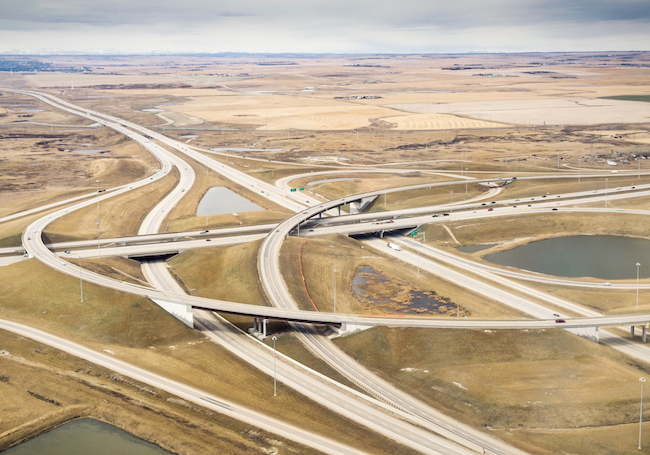

Statistics Canada’s recent survey of the country’s roads found a significant portion across the country to be in less than prime condition. PHOTO: Getty Images
How would you feel if you read a notice in the elevator you were taking to the 30th floor that said 43 per cent of the cable carrying you was in fair to poor condition? Or the pilot announced that 43 per cent of the plane’s wings and fuselage were in fair to poor condition? You would be forgiven for feeling outrage and concern about your safety being placed at risk.
Thankfully, governments are good at regulating the maintenance of those transportation providers to excellent condition and both elevators and planes have exceptional safety records.
So if it’s not acceptable for elevators and planes, why would you accept a similar risk with Alberta’s road infrastructure?
Well there’s bad news on that.
A recent report from Statistics Canada confirms that 43 per cent of Alberta’s highways are in fair, poor or very poor condition. This means right now in our province there are more than 13,500 kilometers of roads requiring some rehabilitation or reconstruction.
In addition to being potentially dangerous; poorly maintained roads are ridiculously expensive. As road quality deteriorates, annual structural maintenance costs skyrocket. For example, instead of paying $3000/km for general upkeep, the outlay for road rehabilitation can be anywhere between $163,000/km and $248,000/km. And when the road is beyond repair, total reconstruction can cost as much as $850,000/km, according to a 2014 Alberta Roadbuilders & Heavy Construction Association white paper.
These expenses simply aren’t practical. Alberta’s transportation infrastructure debt was estimated to be nearly $6 billion in 2014 and that figure will only continue to grow if we fail to take action.
We need to rethink our approach to transportation infrastructure management; the current situation is no longer tenable.
Unfortunately, at a time when we should be investing in our roads, the province has reduced its commitment to planned and needed investment in the maintenance and renewal of roads and bridges by 29 per cent. The continued degradation of our road network will ultimately put pressure on future capital budgets to address these shortsighted decisions.
Without adequate resources it’s impossible to maintain our existing investment or to keep pace with the needs of our growing population. By 2046, 6.4 million people are expected to call Alberta home, adding pressure on our already maxed-out transportation network.
While other jurisdictions are exploring alternate management approaches and more sustainable funding models, Alberta remains locked into the status quo. Given the state of the province’s finances, the current model of management will lead to infrastructure cuts as was necessary in the 1990s. However, this time the road system is in worse condition and can’t absorb years of cuts. This time, we have to earn our way out of the financial pickle we’re in. Fiscal restraint doesn’t have to mean cutting service if we support our political leaders when they are brave and experiment with new asset management models.
Not only are we missing a dependable stream of funding to support long-term investment, we’ve failed to identify an effective mechanism that will drive projects beyond their political expiration date and ensure policy reflects changing socio and economic needs.
Our province is stuck in a shortsighted, stop-and-go cycle that is rapidly increasing our debt and devaluing our future. Given that a recent McKinsey & Company study shows that transportation infrastructure investment typically provides an annual socioeconomic rate of return of 20 per cent for every dollar invested, we are short-changing the economic opportunities today and for future generations.
Whether it’s a main artery, bridge or culvert, transportation infrastructure investments underpin our economy’s ability to grow and function. In 2017, over $8 billion worth of product exports travelled on our highways and roads towards their final destination.
For landlocked provinces such as Alberta, infrastructure renewal, and innovation is key because other viable options simply don’t exist. Now, more than ever, Alberta needs a better model; an improved priority setting system; a renewed commitment to invest; and an enhanced partnership with the public and private sector to build and manage our transportation system.
The Alberta Roadbuilders and Heavy Construction Association wants to bring stakeholders together. We think it is time to discuss the missing strategy for funding connections that are hampering our progress.
We can no longer afford to sit idle. This problem is one that requires our collective attention right now. We all need to care. But possibly most importantly, we need someone who can take the wheel and ensure that our next smooth, great flowing period of economic productivity isn’t too far down the road.
Ron Glen is the CEO of the Alberta Roadbuilders & Heavy Construction Association (ARHCA).
The group represents contractors that work on the construction and rehabilitation of highways, municipal roads, bridges, sewer, and water projects, as well as the suppliers and consulting engineers that work with them.





